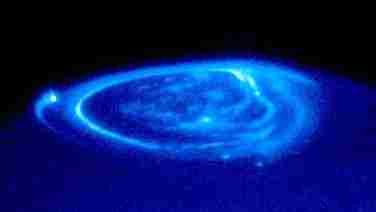|
----------------- a work of fiction Jupiter moons ----------------- to Galileo |
|
|
|
|
|
||
|
----------------- a work of fiction Jupiter moons ----------------- to Galileo |
|
Jupiter also has a giant magnetic field--with an equivalent central magnet about 20,000 times the Earth's, its field at the planet's visible edge about 10 times more intense than ours. Its radiation belt is also much more intense, enough to cause some damage to Pioneer 10, the first space probe to encounter it. The plasma trapped by this field carries a huge ring current, causing a region of weak fields near the equator of the "magnetosphere" of Jupiter, somewhat similar to the middle of the Earth's magnetotail.
 The structure of the radiation belt is not smooth but contains dips due to moons which absorb some of the trapped particles. One dip close to the planet (found by Mario Acuña) seemed not to correspond to any moon: examination of images showed at that distance a thin planetary ring, much thinner than Saturn's but of similar nature. Jupiter also has a bright polar aurora, observed by the Hubble telescope, caused (like Earth's) by energetic electrons colliding with atoms of the upper atmosphere.
The structure of the radiation belt is not smooth but contains dips due to moons which absorb some of the trapped particles. One dip close to the planet (found by Mario Acuña) seemed not to correspond to any moon: examination of images showed at that distance a thin planetary ring, much thinner than Saturn's but of similar nature. Jupiter also has a bright polar aurora, observed by the Hubble telescope, caused (like Earth's) by energetic electrons colliding with atoms of the upper atmosphere.
Jupiter itself is gas, mostly hydrogen, with colorful clouds of ammonia (see image), bands and giant vortexes, some of them quite large and long-lived--like the famous "red spot" (a smaller "red spot" was also noted, and several smaller round features). The equator rotates faster than the poles (though the difference is not as pronounced as it is on the Sun), suggesting an interior convective flow between the equator and the poles. An unsolved puzzle is the reason why Jupiter (and to a lesser degree, other gaseous planets) should be magnetic. Certainly, the dynamo process associated with the Earth's core does not seem likely. Size tends to stretch the time scales of magnetic changes--though size isn't everything, as the relatively fast magnetic cycle of the Sun suggests. One factor is that under the high pressure in Jupiter's center, hydrogen may become a conducting metal, perhaps a resistance-free "superconductor." One would expect hydrogen with its single outermost electron to behave like the metal sodium--but the formation of the molecule H2 interferes with that behavior. Under very high pressure, however, that molecule breaks down. |
Questions from Users: Why don't gas planets just evaporate?
Timeline Glossary Back to the Master List
Author and Curator: Dr. David P. Stern
Mail to Dr.Stern: stargaze("at" symbol)phy6.org .
Last updated: 18 February 2008